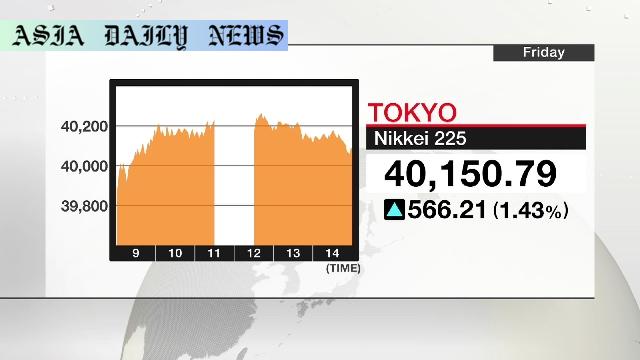Nikkei 225 reaches a year-to-date high of 40,150 as global economic concerns ease and investors gain confidence in the US economy.
Nikkei 225 closed at 40,150, reaching its highest level in six months.
Trade tariff flexibility sparks investor optimism, supporting global economic confidence.
Semiconductor and export-related stocks led the index to a 1.4% gain.
Speculation of US interest rate cuts by the Federal Reserve adds further momentum.

Nikkei 225 Reaches a Significant Milestone
The Nikkei 225, Tokyo’s benchmark stock index, has surged back to the critical 40,000 mark, closing at 40,150 on Friday, marking its year-to-date high. This milestone, achieved after a six-month hiatus, reflects renewed confidence and optimism among investors regarding both Japan’s and the global economy. A notable 1.4% increase in the Nikkei was fueled by strong performances in semiconductor and export-oriented stocks. This trend, correlated with easing concerns about economic slowdowns, provides a positive beacon amidst turbulent global market conditions.
Investors reacted positively to recent developments from the United States, where the Trump administration hinted at extending trade tariff deadlines. This announcement eased fears about prolonged trade tensions negatively impacting economic stability. Additionally, speculations that the Federal Reserve might implement earlier-than-expected interest rate cuts further bolstered the enthusiasm among investors. These factors combined to make a compelling case for growth-oriented stocks, particularly sectors like technology and manufacturing.
Semiconductor and Export Stocks Lead the Rally
The meteoric rise of the Nikkei was heavily driven by gains in semiconductor and export-related shares. Japan’s robust reliance on export markets, paired with increasing demand for semiconductors globally, allowed these industries to act as key drivers of the index’s growth. This resurgence not only reflects the resilience of Japan’s core industries but also their ability to adapt swiftly to global economic headwinds. Technology-related companies, in particular, have been buoyed by increased optimism in their supply chains and the easing of concerns regarding disruptions caused by trade conflicts.
Furthermore, Japan’s position as a key player in global technology and manufacturing supply chains underscores the significant role its exports play in fueling economic recovery. As investors pile into these sectors, the Nikkei’s upward trajectory conveys an increasingly positive sentiment toward long-term growth.
Federal Reserve Speculations Bolster Investor Confidence
Adding to investor confidence are speculations surrounding the Federal Reserve’s monetary policy. Analysts suggest that the Fed may cut interest rates sooner than expected, a move that could drive liquidity into equity markets. Historically, lower interest rates have been associated with increased investor appetite for stocks, as they look for better returns in environments of low borrowing costs. This potential monetary easing in the US indirectly benefits Japanese markets by improving global financial conditions and sparking broader economic optimism.
The prospect of a stable and expanding US economy serves as a significant tailwind for global investors, given the interconnected nature of global markets. For Japan, where export-driven industries rely on a healthy international economy, growing confidence in the US market’s resilience directly translates to increased demand for Japanese goods.
Four-Day Winning Streak Highlights Market Momentum
One of the most notable features of the Nikkei’s performance has been its four-day winning streak, marking a sustained upward trajectory. Investors have consistently placed their bets on the index, backed by positive news surrounding trade discussions and accommodative monetary policy changes. This steady trend underscores a broader shift in investor sentiment, with markets exhibiting resilience against earlier fears of recession and economic contraction.
The momentum also showcases the benefits of continuous adaptation by Japan’s industries to global challenges. Government policies promoting innovation in technology and export capabilities further solidify Japan’s role as a reliable and attractive investment destination. At the core of the Nikkei’s recent rally is the renewed trust in its ability to weather global uncertainties.
Commentary
Positive Sentiments Reinforce Global Economic Stability
The recent rally in Japan’s Nikkei 225 index represents far more than just a surge in stock numbers—it carries symbolic weight for economic optimism across the globe. The reaction of Tokyo’s financial markets to easing trade concerns resonates with investors worldwide who recognize the interconnectedness of modern economies. With tensions in global trade seemingly relaxing and the possibility of monetary easing in the US, markets everywhere are starting to breathe a little easier.
This is particularly encouraging at a time when uncertainty has plagued investor strategies. The willingness of the US government to consider flexibility in trade tariffs reflects a more cooperative and pragmatic approach. For Japan, as a major exporter and a critical player in global supply chains, this implies sustained demand for its goods, especially within industries like semiconductors and technology. When such developments align with market opportunities, it creates fertile ground for lasting economic growth.
Role of Technology-Led Industries in Economic Resurgence
The dominance of semiconductor and export-related shares in the Nikkei’s recent rally is noteworthy. These industries not only highlight Japan’s global relevance but also underscore the market’s confidence in future technological advancements. As the world increasingly relies on technology for transformation across industries, Japan’s position as a major innovator provides it with a unique advantage. These developments pave the way for strategic discussions about investment and growth in global technology markets.
Looking forward, one can only hope that the sustained emphasis on technological innovation will keep Japan, and by extension the global economy, on an upward path. This progress should be complemented by forward-thinking policies and an active stance from major stakeholders to solidify the ongoing recovery.


